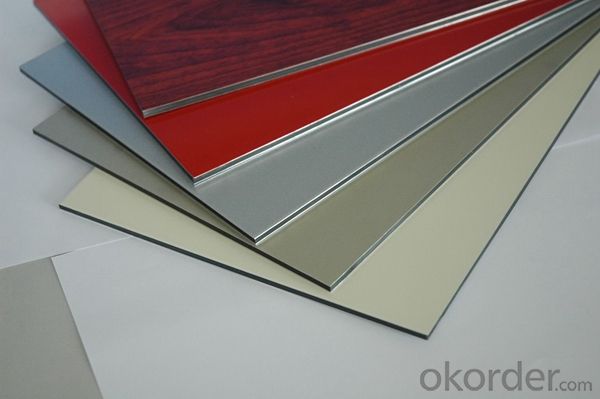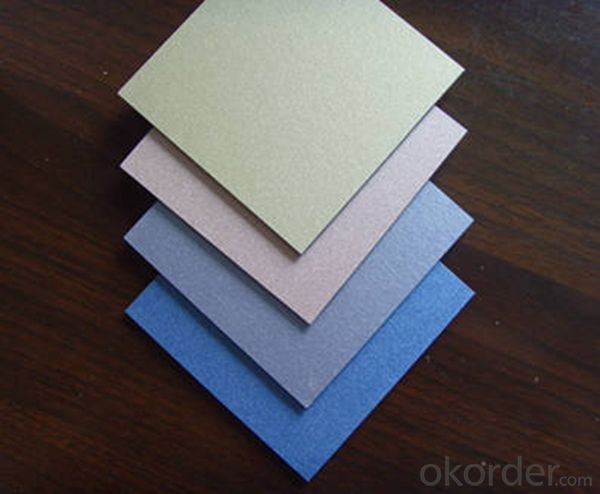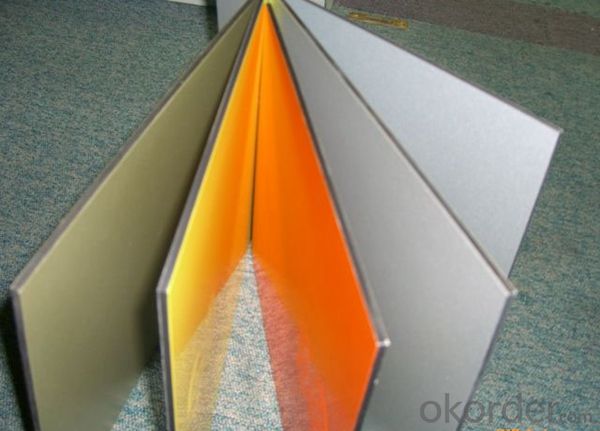Color Coating Aluminium Sheet Plate AA3003 for Building Outside Wall
- Loading Port:
- Shanghai
- Payment Terms:
- TT OR LC
- Min Order Qty:
- 5 m.t.
- Supply Capability:
- 10000 m.t./month
OKorder Service Pledge
OKorder Financial Service
You Might Also Like
Item specifice
1. Specification of Color Coating Aluminium Sheet Plate AA3003 for Building Outside Wall
EQUIPMENT | Double coating double baking; |
CAPACITY | 5000Mt/week |
SIZE | Thickness 0.18mm—2mm, width 40mm—1250mm |
PAINT THICKNESS | Top:18--25um, back:5-7um |
COIL WGT | 3Mt - 8Mt |
COIL ID | φ508mm,φ610mm |
SURFACE PAINT | EP, PE, HDP, SMP, PVDF |
COLOR SERIES | RAL color number series |
2. Application of Color Coating Aluminium Sheet Plate AA3003 for Building Outside Wall
(1).Interior: wall cladding, ceilings, bathrooms, kitchens and balconies, shutters, doors...
(2).Exterior: wall cladding, facades, roofing, canopies, tunnels,column covers , renovations...
(3).Advertisement: display platforms, signboards, fascia, shop fronts...
3. Feature of Color Coating Aluminium Sheet Plate AA3003 for Building Outside Wall
Surfact Quality :
Be free from Oil Stain, Dent, Inclusion, Scratches, Stain, Oxide Dicoloration, Breaks, Corrosion, Roll Marks, Dirt Streaks and other defect which will interfere with use,
Mechenical Property:
Chemical Composite and Mechanical Property
4. Certificate:
SGS and ROHS(if client request, paid by client), MTC(plant provided), Certificate of Origin(FORM A, FORM E, CO), Bureau Veritas and SGS (if client request, paid by client), CIQS certificate
5. Image of Color Coating Aluminium Sheet Plate AA3003 for Building Outside Wall



6. Package and shipping of Color Coating Aluminium Sheet Plate AA3003 for Building Outside Wall
First, plastic cloth with drying agent inside; Second, Pearl Wool ; Third, wooden cases with dry agent , fumigation wooden pallets, aluminum surface could cover blue PVC film
7. FAQ
1) What is the delivery time?
Dpends on actual order, around 20 to 35 days
2)What is the QC system:
We have QC staff of 20 persons and advanced equipment, each production is with MTC traced from Aluminum ingot lot.
3) What market do you mainly sell to?
Australia, America, Asia, Middle East, Western Europe, Africa etc
- Q:Can aluminum sheet be used for food contact applications?
- Yes, aluminum sheet can be used for food contact applications. Aluminum is a widely used material in the food industry due to its excellent properties. It is non-toxic, corrosion-resistant, and has a high thermal conductivity, making it suitable for various food processing and packaging applications. Aluminum sheets can be used to make food containers, trays, and foils, providing a safe and hygienic option for food storage and transportation. Additionally, aluminum is recyclable, making it an environmentally friendly choice for food contact applications.
- Q:Are aluminum sheets suitable for food storage applications?
- Yes, aluminum sheets are suitable for food storage applications. Aluminum is a widely used material in the food industry because it is lightweight, durable, and has excellent thermal conductivity properties. Aluminum sheets are often used to make food storage containers, foil wrap, and trays. These sheets provide an effective barrier against moisture, oxygen, and light, which helps to preserve the freshness and quality of food. Additionally, aluminum is non-toxic and does not react with acidic or alkaline food, ensuring that the taste and safety of the stored food are not compromised.
- Q:What are the different types of surface treatments available for painted aluminum sheets?
- There are several different types of surface treatments available for painted aluminum sheets. These treatments are designed to enhance the appearance and durability of the aluminum, as well as provide protection against corrosion and other forms of damage. One common type of surface treatment is anodizing. Anodizing involves immersing the aluminum sheets in an electrolytic solution and passing an electric current through them. This process creates a protective oxide layer on the surface of the aluminum, which not only improves its corrosion resistance but also provides a base for painting or other decorative finishes. Another popular surface treatment for painted aluminum sheets is powder coating. Powder coating involves applying a dry powder to the surface of the aluminum and then heating it to form a tough, protective layer. This coating is known for its durability, resistance to fading and chipping, and ability to provide a wide range of colors and finishes. In addition to anodizing and powder coating, there are also other surface treatments available for painted aluminum sheets. These include chemical conversion coating, which involves applying a chemical solution to the aluminum to create a protective layer, and laminate coatings, which involve applying a thin film or laminate to the surface for added protection and decoration. Overall, the different types of surface treatments available for painted aluminum sheets offer a variety of benefits, including enhanced appearance, improved durability, and increased resistance to corrosion. The choice of surface treatment will depend on the specific requirements and desired outcomes for the aluminum sheets in question.
- Q:I am doing some exam review and do not know how to do these...Calculate the number of Nitrate ions in 3.99 g or aluminum nitrate.
- OK - first you need the ENTIRE mass of the aluminum nitrate (gram formula mass). You need the correct formula for aluminum nitrate, then add up the atomic masses from the periodic chart. Then, you need to convert 3.99 g of aluminum nitrate to moles of aluminum nitrate. (grams/formula mass = moles) Then, you need to take into account how many moles of nitrate ions are in a mole (look at the correct formula for aluminum nitrate). Then multiply by the number of moles you calculated (moles of ions per molecule x #moles). This would be moles of ions. You need individual ions you would the multiply by 6.02 x 10^23 ions/mole. SO: grams of sample divided by formula mass x #nitrate ions per molecule x (6.023 x 10^23 ions per mole) = # ions
- Q:What is the typical tensile strength of aluminum sheets?
- The typical tensile strength of aluminum sheets can vary depending on the specific alloy and temper, but it is generally in the range of 20,000 to 45,000 pounds per square inch (psi).
- Q:What are the different alloys available for aluminum sheets?
- Aluminum sheets offer a range of options when it comes to alloys, each with its own distinct properties and uses. Let's take a look at some of the most commonly used alloys: 1. 1100: This alloy is pure aluminum and boasts exceptional resistance to corrosion. It is perfect for applications that demand high levels of protection against corrosion, such as marine environments. 2. 3003: Another alloy that is purely aluminum, 3003 offers good formability, moderate strength, and high resistance to corrosion. It finds its place in general sheet metal work, chemical equipment, and cooking utensils. 3. 5052: Known for its impressive fatigue strength and outstanding resistance to corrosion, especially in saltwater settings, this alloy is often employed in marine applications, as well as aircraft components and fuel tanks. 4. 6061: As a heat-treatable alloy, 6061 showcases excellent weldability and formability, along with elevated strength and superb corrosion resistance. It is commonly utilized in structural components like frames, railings, and automotive parts. 5. 7075: This alloy stands out for its remarkable strength-to-weight ratio, making it perfect for aerospace applications and structural components that face high levels of stress. However, it is less resistant to corrosion than other alloys and may require protective coatings in specific environments. These examples represent only a fraction of the aluminum sheet alloys available. The choice of alloy relies on the specific requirements of the application, considering factors such as strength, corrosion resistance, formability, and cost. It is crucial to consult a knowledgeable supplier or engineer to determine the most appropriate alloy for your particular needs.
- Q:What is the typical weldability of aluminum sheets?
- The typical weldability of aluminum sheets is considered to be excellent. Aluminum is known for its high weldability due to its low melting point and thermal conductivity. It can be easily joined using various welding techniques such as TIG (tungsten inert gas), MIG (metal inert gas), and even spot welding. The weldability of aluminum sheets is further enhanced by the use of filler materials specifically designed for aluminum welding. However, it is important to note that the weldability can vary depending on the alloy composition, thickness, and surface condition of the aluminum sheet.
- Q:Are aluminum sheets suitable for aviation applications?
- Indeed, aviation applications can make effective use of aluminum sheets. The aviation industry extensively employs aluminum owing to its lightweight nature, impressive strength-to-weight ratio, and ability to resist corrosion. Aluminum finds applications in the manufacturing of aircraft, including critical components like the fuselage, wings, and structural elements. By utilizing aluminum sheets, the aircraft not only gain structural integrity but also experience reduced weight, thereby enhancing fuel efficiency and overall performance. Furthermore, the versatility of aluminum sheets allows for easy shaping and fabrication, making them highly adaptable for diverse aviation purposes.
- Q:I may use the copper or brass for an inlay on a decorative piece of aluminum I'm working on.....
- Melting Point Of Brass
- Q:Are aluminum sheets suitable for heat exchangers?
- Yes, aluminum sheets are suitable for heat exchangers. Aluminum is a highly conductive metal, which allows for efficient heat transfer. Its lightweight nature makes it easy to handle and install in heat exchanger systems. Additionally, aluminum is highly resistant to corrosion, ensuring the longevity and durability of the heat exchanger. Furthermore, aluminum sheets can be easily formed into different shapes and sizes, making them customizable for various heat exchanger designs. Overall, aluminum sheets offer excellent thermal conductivity, corrosion resistance, and versatility, making them a suitable choice for heat exchanger applications.
1. Manufacturer Overview |
|
|---|---|
| Location | |
| Year Established | |
| Annual Output Value | |
| Main Markets | |
| Company Certifications | |
2. Manufacturer Certificates |
|
|---|---|
| a) Certification Name | |
| Range | |
| Reference | |
| Validity Period | |
3. Manufacturer Capability |
|
|---|---|
| a)Trade Capacity | |
| Nearest Port | |
| Export Percentage | |
| No.of Employees in Trade Department | |
| Language Spoken: | |
| b)Factory Information | |
| Factory Size: | |
| No. of Production Lines | |
| Contract Manufacturing | |
| Product Price Range | |
Send your message to us
Color Coating Aluminium Sheet Plate AA3003 for Building Outside Wall
- Loading Port:
- Shanghai
- Payment Terms:
- TT OR LC
- Min Order Qty:
- 5 m.t.
- Supply Capability:
- 10000 m.t./month
OKorder Service Pledge
OKorder Financial Service
Similar products
New products
Hot products
Related keywords



























